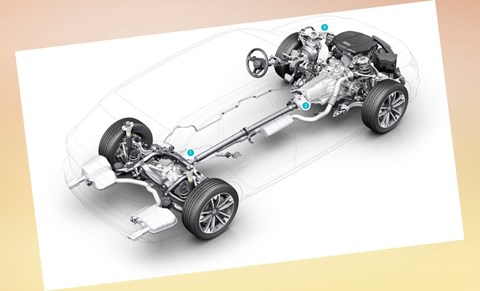► New quattro system swaps between fwd and awd
► No more centre differential, clutches take over
► Coming first to the Audi A4, then Q5, A5 and Q7
Permanent four-wheel drive has been at the heart of Audi’s core quattro models ever since the original Ur-Quattro yumped onto the scene in 1980.
But its latest-generation system is anything but permanent. Instead it switches between front- and four-wheel drive in milliseconds and bins the traditional centre diff for a pair of clutches controlled by a network of sophisticated electronics.
The goal is efficiency: the rear wheels are brought into play near-instantaneously when needed, but most of the time the car is front-wheel drive and, thanks to lower frictional losses, more fuel efficient.
Audi calls the new-generation system ‘Quattro with Ultra’; Ultra being its conspicuously parsimonious sub-brand. Surely ‘Quattro with Duo’ would be more appropriate? The new system will be rolled out across some versions of Audi’s longitudinally-engined models from mid-2016, starting with the new A4 Allroad and, later, the next Q5, A5 and Q7.
How much fuel does it actually save?
Audi says its developers averaged 0.3 fewer litres (0.07 gallons) for every 62 miles covered than a standard Torsen model over its test route. A purely front-drive model would use around 0.2 litres fewer still.
How does it feel to drive?
We drove a pre-production A4 Avant with the system on a 40-mile mixed-road route. The switch between 2wd and 4wd was genuinely impossible to detect from behind the wheel. We spent a surprisingly symmetrical 51% of the trip in 2wd mode and 49% in 4wd, with a steep, twisty section accounting for much of the time the car spent with its rear wheels engaged.
How it works

1) Rear de-coupler
As the system enters front-drive mode, the rear decoupling device opens to prevent the rear differential creating unnecessary drag. A spring-loaded locking lever re-engages the clutch to return drive to the rear wheels.
2) Multi-plate clutch
Positioned on the end of the gearbox and activated by an electric motor, the front clutch unit disconnects and reconnects the propshaft to switch between 2wd and 4wd. It also divvies up the proportion of torque front-to-rear in 4wd mode.
3) The nervous system
Audi reckons it can engage four-wheel drive half a second before it‘s needed. A complex network of sensors and control units pore over a huge pool of data – steering angle, yaw, predicted tyre contact patches – and decide when to cut drive to the rear and when to reintroduce it.
Read more from the April 2016 issue of CAR magazine